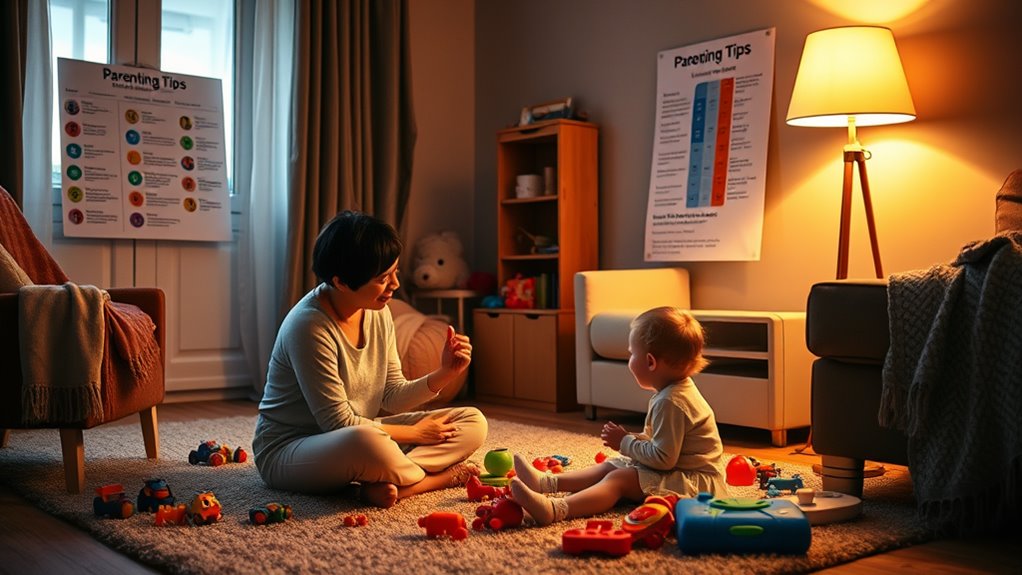Setting clear boundaries for your kids is super important! Think of it like giving them a map; they know where to go and where not to wander off. When you set these limits, it helps them learn acceptable behavior and teaches respect for themselves and others. Plus, it creates a safe space for them to explore and make choices. Consistently enforcing boundaries means less stress for you and fewer conflicts overall. And, let's be honest—kids love testing limits, so clear rules help keep things peaceful. So, if you're curious about how to set those boundaries effectively, there's plenty more to discover!
Understanding Boundaries
When it comes to understanding boundaries, many parents often underestimate their importance in a child's development. You might think boundaries are just rules, but they're much more than that! They help kids learn what's acceptable and what's not. Imagine trying to play a game without any rules—chaos, right? Well, boundaries create a safe space where kids can explore and grow without feeling lost.
Think of boundaries as a fence around a yard. They keep children safe while still allowing them to play and have fun. When you set clear boundaries, you're teaching your child to respect themselves and others. It's like giving them a map to navigate their feelings and relationships.
Sure, kids might test those boundaries sometimes, pushing buttons like a game show contestant, but that's part of learning!
Also, remember, boundaries aren't about being strict; they're about being consistent. Your child needs to know what to expect from you. So, when you explain the "why" behind rules, you help them understand their importance.
After all, everyone, even kids, thrives when they know their limits! So, let's dive deeper into the benefits of having those clear boundaries.
Benefits of Clear Boundaries
Clear boundaries offer a solid foundation for children to thrive emotionally and socially. When you set clear rules and expectations, kids know what's acceptable and what isn't. This clarity helps them feel safe and secure, like having a cozy blanket on a chilly night.
With boundaries in place, your child can explore their world without fear of the unknown. They learn to make choices, understand consequences, and develop self-discipline. Imagine them playing at the park, knowing where they can run free and where to stop. Boundaries give them that freedom!
Additionally, clear boundaries help improve behavior. Instead of testing limits, your child learns to respect them. This can lead to fewer arguments and a more peaceful home. Plus, when kids understand what's expected, they're often more willing to cooperate. It's like having a secret code that makes life easier for everyone!
Finally, clear boundaries promote better relationships. When kids know how to treat others and what's expected of them, they build trust with peers and adults alike.
Impact on Child Development
Setting boundaries plays an essential role in your child's development, shaping their understanding of the world around them. When you set clear limits, you help your child learn what's acceptable and what isn't. It's like giving them a roadmap to navigate life's twists and turns. Without those boundaries, kids might feel lost, and that can lead to confusion or misbehavior.
You might think, "But my kid hates rules!" Well, here's the secret—kids actually thrive on consistency. When you establish boundaries, they feel secure and know what to expect. This security helps them develop self-discipline, which is super important as they grow. They'll learn to make better choices, even when you're not around.
Plus, boundaries encourage healthy relationships. Your child learns to respect others' limits, too. It's a win-win!
And let's be honest, setting boundaries can even save your sanity. You won't always have to play referee in every situation, and that means more peace for you both.
Creating Effective Boundaries
Establishing effective boundaries involves being intentional and consistent about the rules you set. Think of boundaries like the lines on a soccer field; they help kids understand where they can play and when they need to stop.
Start by identifying what's important to you and your family. Is it screen time? Homework? Chores? Once you've got your priorities sorted, it's time to communicate those rules clearly.
Next, make sure you're consistent. If you say bedtime is at 8 PM, stick to it! Kids thrive on routine, and changing things up can confuse them. Plus, they might test those boundaries like a cat testing a new box—pushing to see if it fits!
Don't forget to be flexible too. As your child grows, their needs will change, and so should the boundaries. You can always adjust them, like upgrading from a tricycle to a bike.
Just remember, effective boundaries aren't about being strict; they're about providing a safe space where your child can explore and learn. So, set those lines, keep them clear, and watch your child flourish within them!
Communicating Boundaries to Children
When discussing boundaries with your child, focus on being direct and engaging. Start by using simple language that they can easily understand. Instead of saying, "You mustn't touch that," try, "Let's keep our hands off the snacks until after dinner." This way, you're explaining the rule while also making it relatable.
Be sure to explain why boundaries matter. For instance, you could say, "We need to share our toys so everyone has fun!" This helps them see the bigger picture and understand that boundaries aren't just rules but tools for harmony.
Use examples from their daily life. If they're having trouble with a friend, you might say, "It's important to respect each other's space, just like we do at home." This connects the dots between home and their outside world.
Lastly, encourage questions. If they seem confused or curious, ask them what they think about the boundaries. This makes them feel involved and valued.
Enforcing Boundaries Consistently
And don't forget to celebrate when they follow the rules! A simple high-five or a cheerful "Great job!" goes a long way.
It reinforces their positive behavior and shows that you're proud of them.
Adjusting Boundaries as Needed
As your child becomes more accustomed to the boundaries you've set, you might find that some rules need tweaking. Kids grow and change faster than a speeding train, and what worked last month mightn't fit today. It's crucial to stay flexible and adjust those boundaries as needed.
Start by observing how your child responds. Are they testing limits? If so, it could mean they need more freedom or a different approach. Maybe they're ready for a later bedtime or more responsibility with chores. Talk to them about it! You might be surprised by their insights.
Remember, boundaries aren't just about saying "no." They're about guiding your child to make smart choices. So, if you notice a rule feels too strict or isn't working, don't hesitate to discuss it. You can even make adjusting boundaries a fun family conversation—like a mini negotiation!
Just keep in mind that changes should still align with your core values. Setting clear limits is important, but so is being open to change. Balancing both helps your child feel secure while encouraging their independence.
After all, parenting is a journey, not a straight line!





